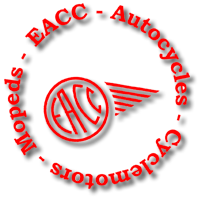


What is a Wilfred? Or a Clip-on? Or, come to that, a cyclemotor?
Basically, it’s a big moped: a motor cycle with pedals and an engine of up to 100cc capacity.
Original French term for cyclemotor. It has been superseded by cyclomoteur—although cyclomoteur does not distinguish between cyclemotor and moped.
Bicyclette à Moteur Auxilaire. Although literally equivalent to MAC it is closer in meaning to autocycle.
Dutch term for a moped. Bromfeitsen are legally limited to 45km/h, cf: snorfiets.
An early name for a moped, the term was used to distinguish them from clip-on cyclemotors.
Another name for a cyclemotor. The name derives from it being an engine that could be ‘clipped on’ to a pedal cycle
French for a moped, often abbreviated to ‘cyclo’. Cyclomoteur is a legal category in France just as Moped is in the UK.
In the 1950s it was suggested that the term cyclomoteur should be used in the UK to describe purpose-built, built-in machines (like the Mobylette) to distinguish them from Cyclemotors. It didn’t catch on.
A pedal cycle with an auxiliary engine. Various other names were used before the term cyclemotor won the day, eg: MAC & Clip-on
Popular term for a French BMA of the 1930s with a step-through frame. This type of machine was popular among Roman Catholic priests as it could be ridden while wearing a cassock.
A moped. A light autocycle was an autocycle but with a smaller (ie: under 50cc) engine. The term was used in the early 1950s, before the word moped was adopted.
Motor Assisted Cycle. Another name for a cyclemotor.
French slang for a moped, short for Mobylette.
Mobylette is a trade name used by the French company Motobécane for its mopeds. In French Mobylette has become a generic term for moped (much in the way Hoover has become a popular term for any vacuum cleaner in English).
A motorised bicycle (abbreviation of Motorfahrrad). In Germany the Mofa is the equivalent of the Dutch snorfiets and is limited to 25km/h.
German scooterette limited to 25km/h.
An under-50cc motor cycle with a kick-start instead of pedals.
German scooterette limited to 40km/h.
Basically, a motor cycle with pedals and an engine of less than 50cc capacity. But it’s not that simple…
In the UK, Moped is a legal category. It used to mean an under 50cc machine with pedals but, faced with increasing power outputs from 50cc engines the legal definition was changed in the 1970s. Then it became an under-50cc machine that’s restricted to a maximum speed of under 30mph—and the pedals weren’t legally necessary any more. From June 2003, the definition changed again, limiting the maximum speed to 45km/h. Since the standardisation of European driving licences, the definition has changed again: the Europe-wide definitioin is an under-50cc machine with a top speed between 25km/h and 45km/h and in the UK we add under-50cc machines with a maximum speed under 25km/h and under-50cc machines that can be pedalled.
A scooter that is also a moped, ie: has an engine of less than 50cc capacity. Some machines that were described as scooterettes, particularly in the days when pedals were a legal requirement for a moped, didn’t even have a foot board—they were just mopeds with a lot of superfluous bodywork.
A sub-set of moped in the Netherlands and Belgium—equivalent to the mofa in Germany. The maximum speed of a snorfiets is restricted to 25km/h (cf: bromfiets). They are free of many other legal requirements and may be used on all cyclepaths. A helmet is not needed when riding a snorfiets in the Netherlands—but it is required in Belgium.
A moped or small motor cycle with an open frame so it can be mounted by stepping through the frame. Differs from a scooter as it has foot rests or pedals rather than a platform for the feet.
From 5 June 1943 onwards, vélomoteur is the French administrative term for a motor cycle of 50cc or more but less than 125cc. Before 1930 it meant a motor cycle with pedals, weighing less than 30kg, less than 100cc and limited to 30km/h. Then the weight limit was increased to 35kg and the speed limit was removed, making it more-or-less the same as our autocycle.
Alledgedly, a pre-World War 2 nickname for an autocycle. Small capacity motor cycles were popularly known as ‘pip-squeaks’. When autocycles appeared in the late 1930s, the name Wilfred (after the popular cartoon strip ‘Pip, Squeak and Wilfred’) was applied to them. The term was regularly used within the pages of the Green ‘un, but its use may not have extended far beyond the staff and readership of that magazine.
Enquiries about the EACC should be sent to .

Last Modified 18 April 2023
Go to Autocycle Central